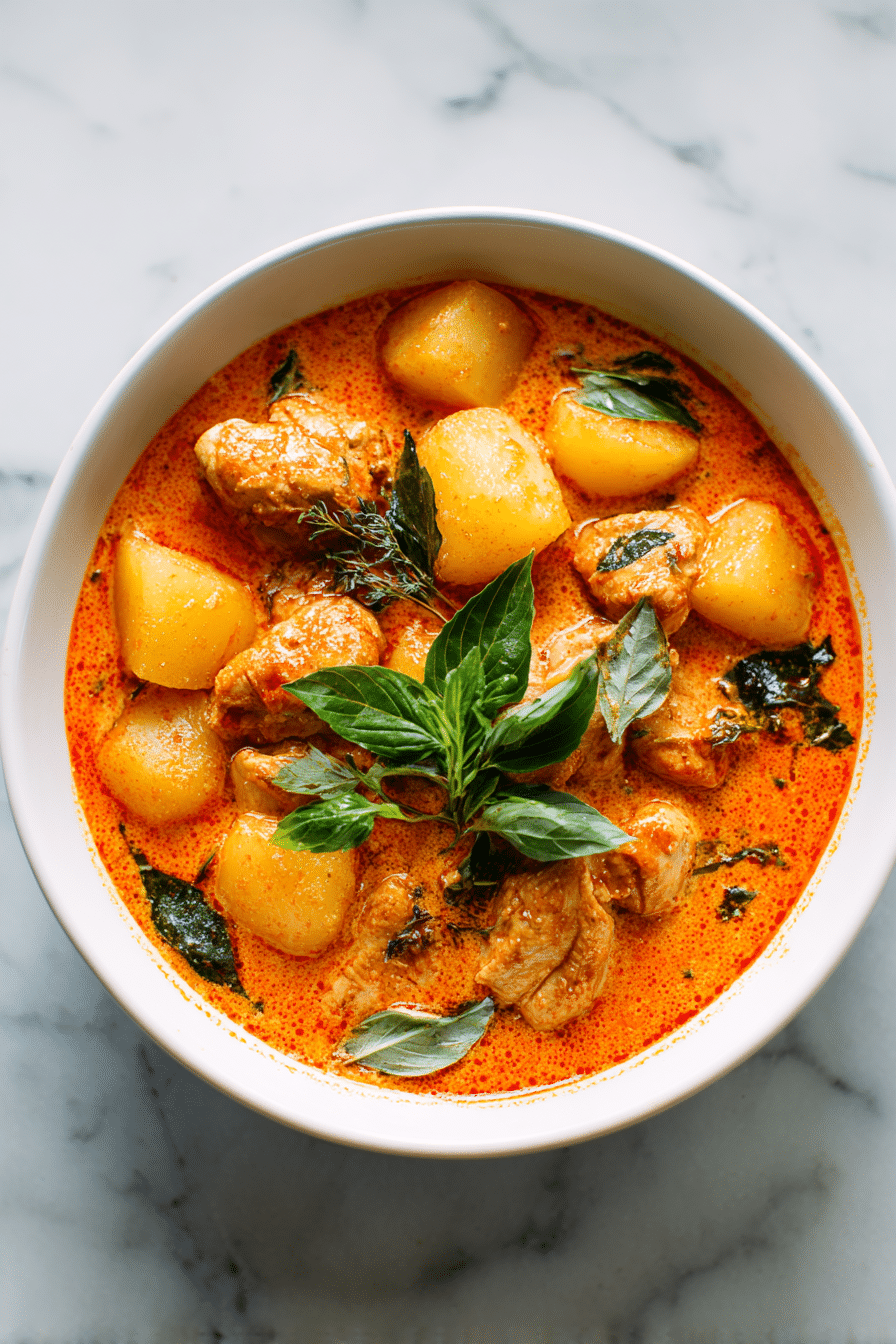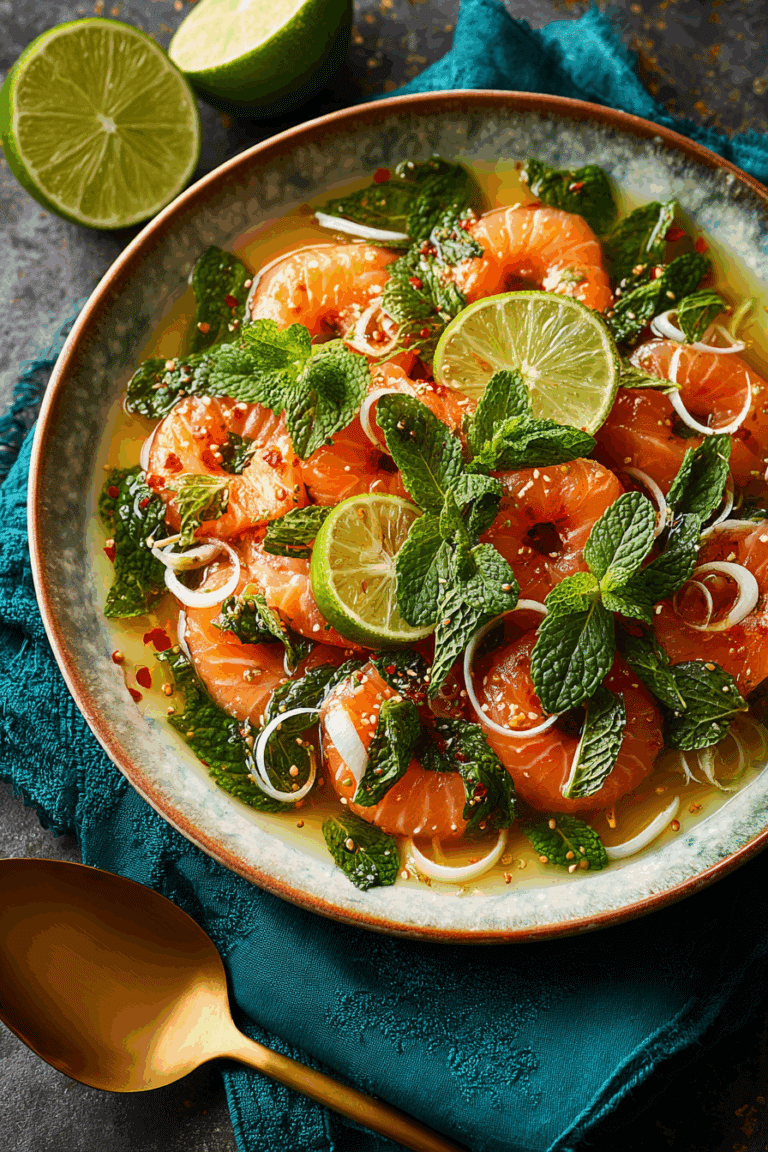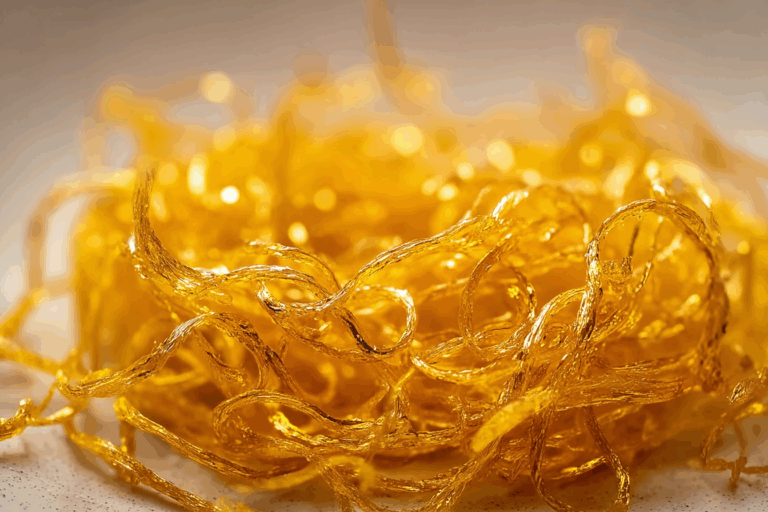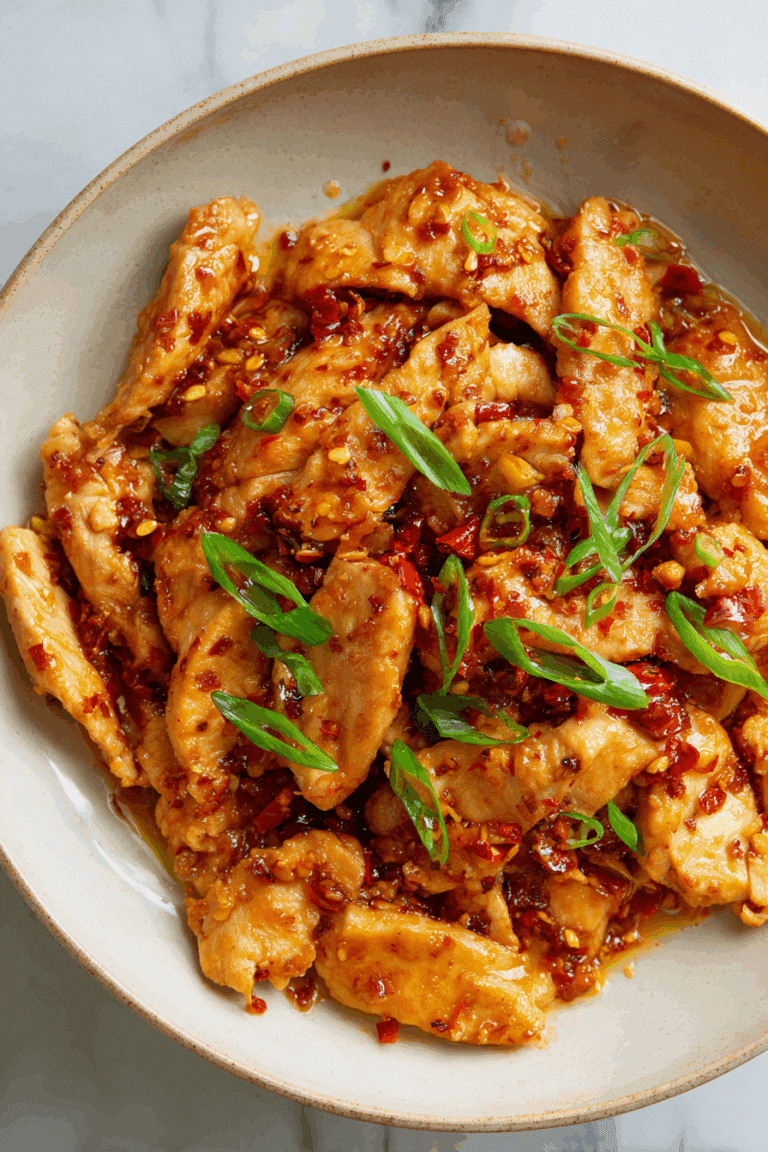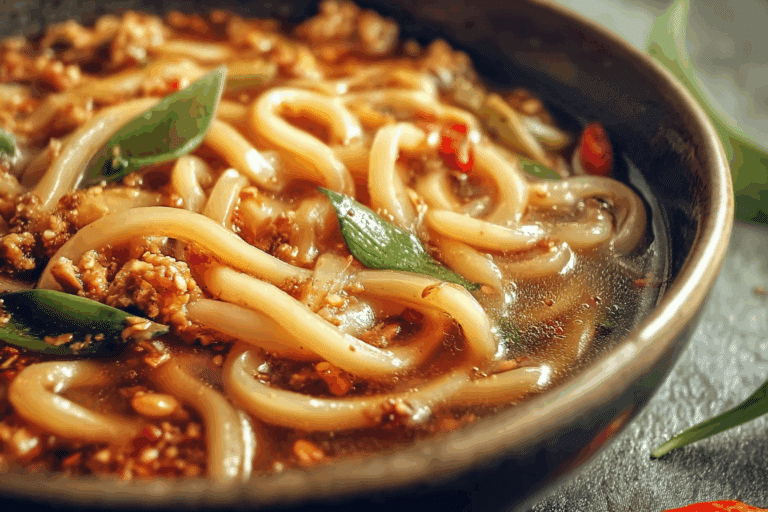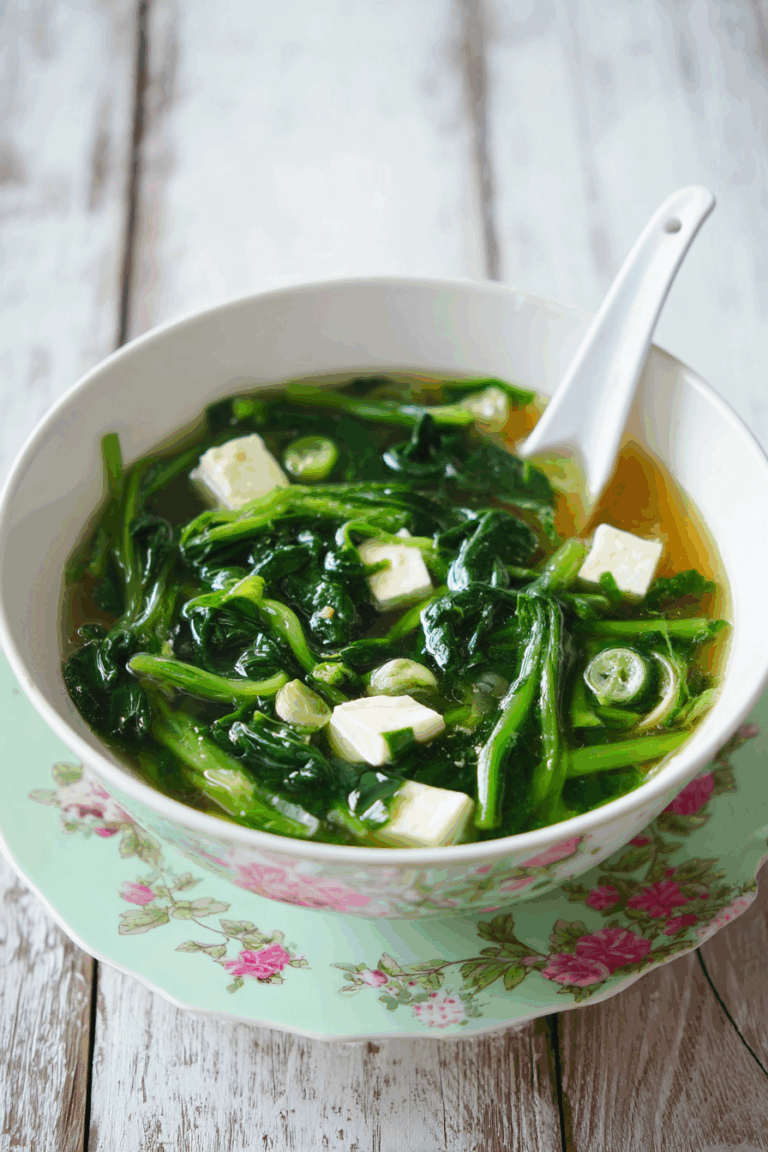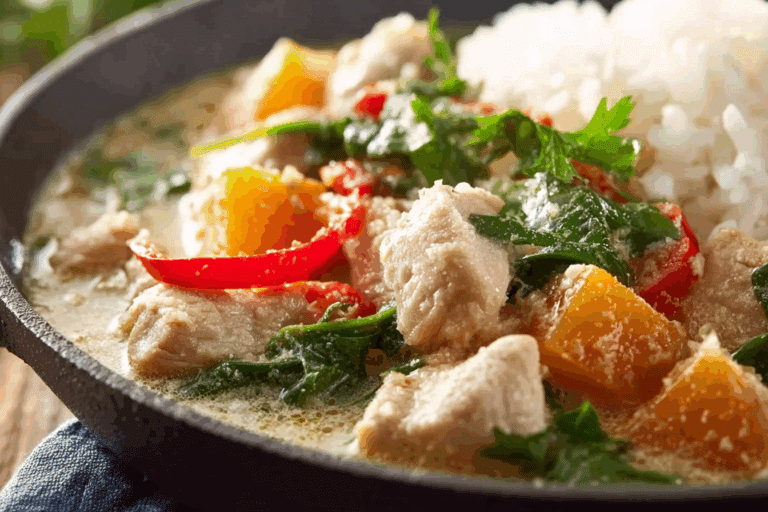Thai Chicken with Red Sauce You’ll Make Again and Again
Thai Chicken with Red Sauce is more than just a recipe it’s a warm, flavorful journey into Thai cuisine that has captured hearts around the world. When I first began cooking Thai food, I was fascinated by how a single dish could balance sweet, spicy, savory, and creamy flavors in perfect harmony.
On the About page of Just Thai Recipes, I shared how my love for Thai food started during a trip to Bangkok, where the aroma of sizzling street food stalls filled the air. One dish in particular stood out: authentic Thai Chicken with Red Sauce served with jasmine rice. The vibrant red curry sauce, creamy coconut milk, and fragrant Thai basil leaves instantly won me over.
That first taste sparked a lifelong passion for recreating traditional Thai flavors in my kitchen. Over the years, I’ve experimented with many curry pastes, different vegetables, and various cooking methods to perfect this recipe. In today’s blog post, I’ll take you through every detail of making Thai Chicken with Red Sauce at home.
You’ll learn the exact ingredients, step-by-step instructions, tips, mistakes to avoid, storage hacks, cultural background, and delicious serving ideas. By the end, you’ll be confident enough to serve a bowl of Thai Chicken with Red Sauce that tastes like it came straight out of a Thai street market.
Whether you’re searching for traditional Thai chicken with red sauce, an easy Thai chicken with red sauce recipe for busy weeknights, or the best Thai chicken with red sauce version with pumpkin and beans, this guide will cover it all.
Table of Contents
Table of Contents
Ingredients
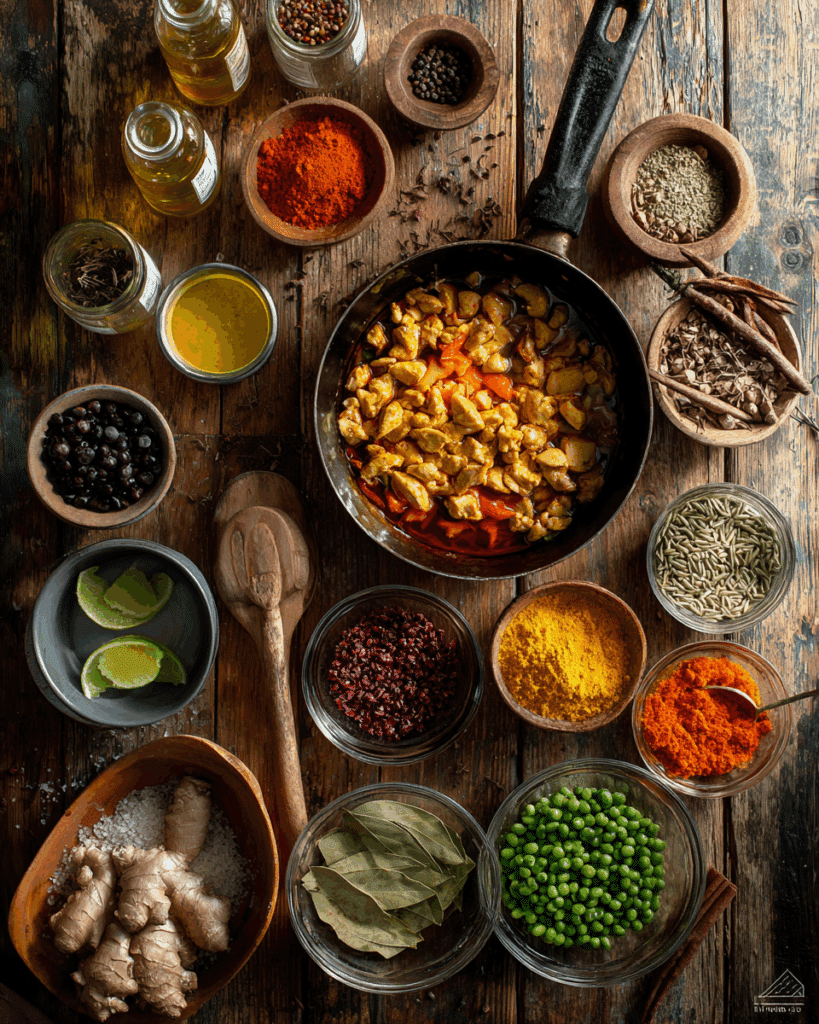
To make authentic Thai Chicken with Red Sauce, you’ll need fresh herbs, rich coconut milk, and a punchy curry paste. The secret lies in choosing the right red curry paste—either store-bought (Maesri is the best option) or homemade. Here’s everything you’ll need for a well-balanced curry that’s flavorful and satisfying.
Red Curry Paste – choose ONE:
- 5 – 6 tbsp Thai Red Curry Paste (store bought, Maesri best) (Note 1)
- 1 quantity homemade Thai Red Curry Paste
Extras – only for jar curry paste (Note 2):
- 2 large garlic cloves, minced
- 2 tsp fresh ginger, finely grated
- 1 tbsp lemongrass paste or finely chopped fresh (Note 3)
Thai Red Curry Base:
- 3 tbsp vegetable oil (or canola or peanut)
- 1 cup (250 ml) chicken broth/stock, low sodium
- 400 ml / 14 oz coconut milk (full fat!)
- 6 kaffir lime leaves (Note 4)
- 1 tbsp sugar (white, brown or palm)
- 2 tsp fish sauce, plus more to taste
Protein and Vegetables:
- 350g / 12 oz chicken thighs (boneless and skinless), cut into 0.75 / 1/3″ thick slices (Note 5)
- 150g / 5 oz pumpkin or butternut squash, cut into 1.5cm / 3/5″ cubes (~1 heaped cup)
- 120g / 4oz green beans, trimmed and cut into 5cm/2″ pieces
- 12 Thai basil leaves (Note 6)
Garnishes (optional) & serving:
- Fresh red chili slices (small chili = spicy, large = less spicy)
- Fresh coriander / cilantro leaves
- Steamed jasmine rice
Tip: Always use full-fat coconut milk for a creamy sauce. Light versions tend to break apart and don’t give the silky texture authentic Thai curries are known for.
Looking for more Thai-inspired recipes? Check out this Just Thai Recipes collection of chicken curries for more inspiration.
Step-by-Step Instructions
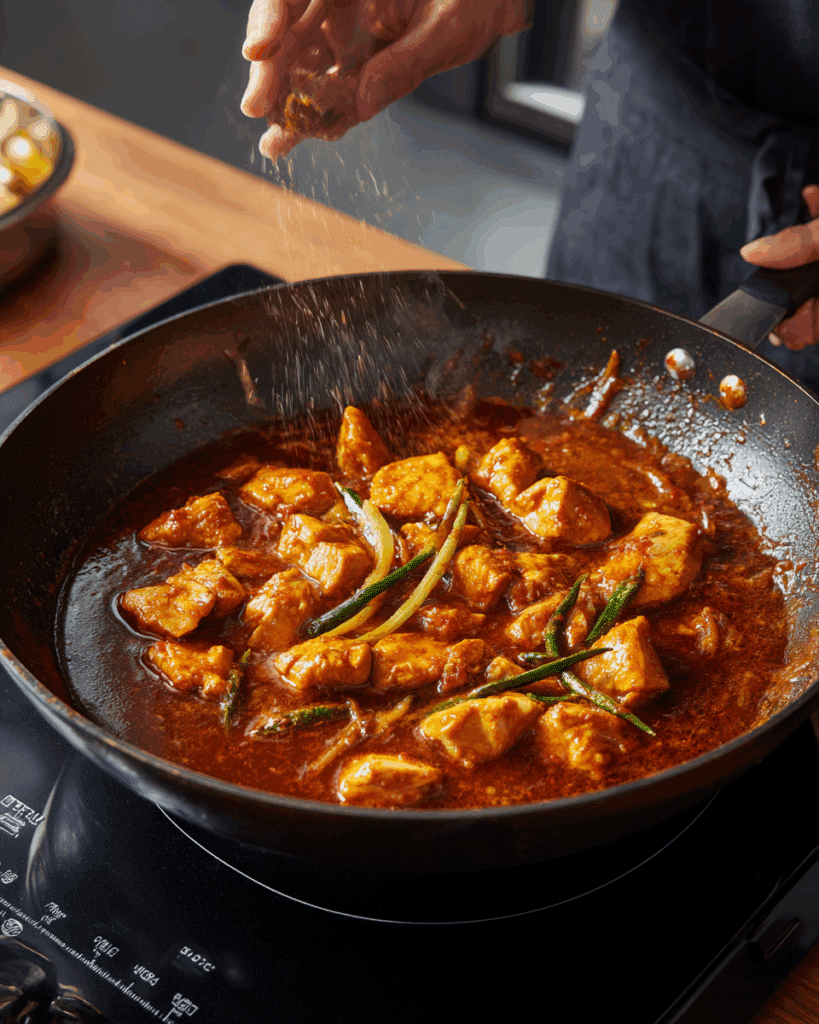
Cooking Thai Chicken with Red Sauce might seem intimidating at first, but once you learn the flow, it becomes second nature. Thai cooking is about layering flavors, which means taking time to sauté curry paste, simmer coconut milk, and balance sweet, salty, and spicy notes.
- Heat the oil: Start with a large heavy-based skillet or wok. Add vegetable oil and heat over medium-high.
- Cook the curry paste: Add your chosen red curry paste. If you used jar curry paste, also add garlic, ginger, and lemongrass. Sauté for about 2 minutes until the paste begins to “dry out” and release a rich aroma. This step is essential to wake up the spices.
- Add broth: Stir in chicken broth to dissolve the curry paste completely. Let it simmer rapidly for 3 minutes until the liquid reduces by half.
- Add coconut milk & seasonings: Pour in coconut milk, lime leaves, sugar, and fish sauce. Stir well.
- Cook the chicken: Add sliced chicken thighs, spreading them evenly in the sauce. Bring to a gentle simmer, then lower heat to medium. Let it cook for 8–10 minutes, until chicken is tender and sauce thickens slightly.
- Taste & adjust: Do a quick taste test. Add more fish sauce for saltiness or sugar for sweetness until the balance feels right.
- Add vegetables: Stir in pumpkin and green beans. Simmer for 3 more minutes until vegetables are just tender and sauce is glossy.
- Finish with basil: Remove from heat and fold in Thai basil leaves.
- Serve: Ladle over steamed jasmine rice. Garnish with chili slices and cilantro if desired.
This is the foundation of Thai Chicken with Red Sauce—a velvety curry with chicken, vegetables, and aromatic herbs that’s ready in under 40 minutes.
👉 For a different take on Thai red curry chicken and vegetables, check out these external recipes: Thai Red Curry with Chicken and Thai Red Curry Chicken with Vegetables.
Tips and Tricks
Making Thai Chicken with Red Sauce isn’t complicated, but a few chef’s tricks can make your curry shine.
- Choose the right curry paste: If using store-bought, Maesri brand is highly recommended for depth of flavor. Homemade paste, of course, gives you total control over spice levels.
- Balance the flavors: Authentic Thai curries rely on the harmony of sweet (sugar), salty (fish sauce), creamy (coconut milk), and spicy (red curry paste). Always taste before serving.
- Use chicken thighs, not breasts: Thigh meat stays juicy and tender, while chicken breast can dry out in curries.
- Cut vegetables evenly: This ensures pumpkin and green beans cook at the same pace.
- Don’t skip kaffir lime leaves: They add a citrusy aroma that defines the flavor of Thai Chicken with Red Sauce.
- Simmer gently: High heat can split coconut milk. Keep the sauce at a gentle simmer for a silky finish.
- Reheat gently: When reheating, add a splash of coconut milk or chicken stock to bring back creaminess.
In Thai cuisine, patience and tasting along the way make all the difference. Each spoonful of Thai Chicken with Red Sauce should feel layered, balanced, and deeply satisfying.
Variations
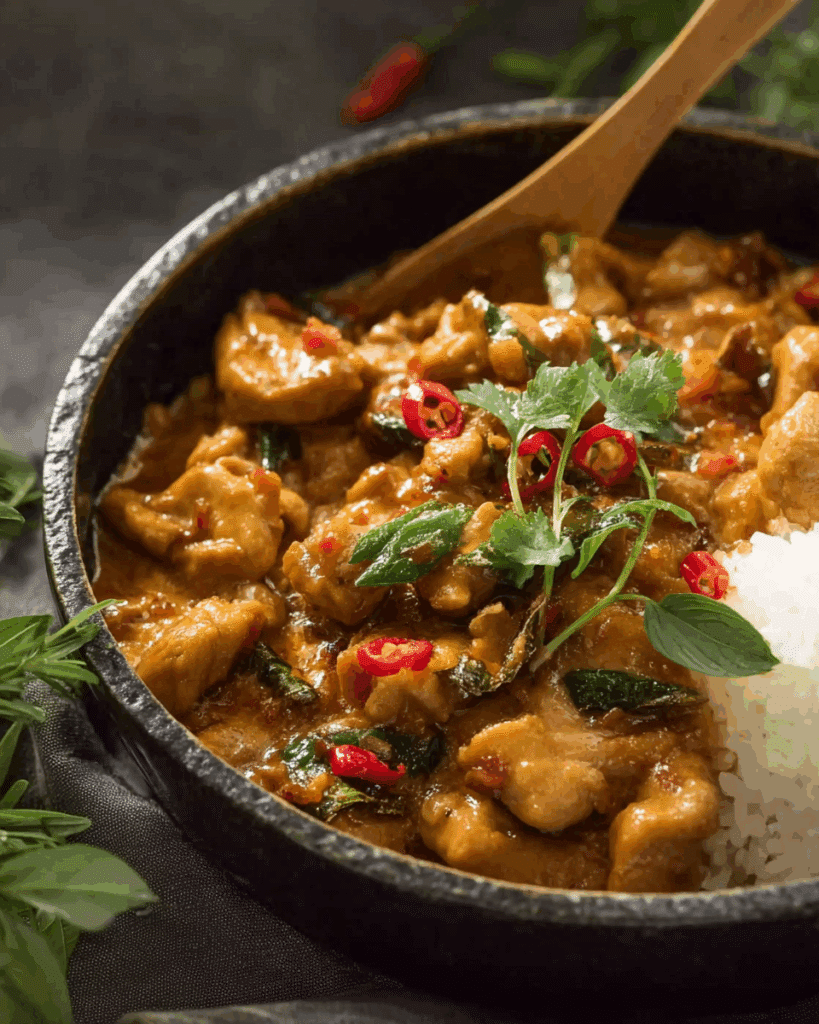
Thai Chicken with Red Sauce is one of those recipes that invites creativity. While the traditional version uses chicken thighs, pumpkin, green beans, and Thai basil, you can easily adapt the recipe based on what’s in your pantry or your personal flavor preferences. In Thailand, street food vendors often customize curry bowls for customers, and you can do the same at home. Here are several delicious variations to try:
1. Traditional Thai Chicken with Red Sauce
The traditional version stays true to authentic Thai cooking by using homemade curry paste, kaffir lime leaves, and Thai basil. If you want the flavor closest to what you’d get in Bangkok, this is the way to go. Traditional Thai Chicken with Red Sauce is often cooked with chicken thighs, served over jasmine rice, and garnished with chili slices for an extra kick.
2. Easy Thai Chicken with Red Sauce
For busy weeknights, the easy version is your best friend. Use store-bought red curry paste, pre-cut vegetables, and canned coconut milk. This shortcut allows you to have dinner ready in under 30 minutes without compromising too much on flavor. Many home cooks in the U.S. prefer this variation because it delivers restaurant-quality taste with minimal effort.
3. Authentic Thai Chicken with Red Sauce and Rice
This variation focuses on authenticity and pairing. The curry itself doesn’t change much, but it’s all about serving. Authentic Thai Chicken with Red Sauce is never complete without perfectly steamed jasmine rice. The rice soaks up the creamy coconut sauce, balancing spiciness and sweetness. You can even try sticky rice for a more rustic Thai experience.
4. Thai Chicken with Red Sauce and Vegetables
If you love more veggies, load your curry with bell peppers, zucchini, baby corn, mushrooms, or eggplant. Thai red curry chicken and vegetables is one of the healthiest and most colorful ways to enjoy this dish. Not only does it look beautiful in the bowl, but it also adds layers of texture.
5. Thai Red Curry Chicken Recipe with Shrimp Paste Twist
Some cooks enhance Thai Chicken with Red Sauce by adding a touch of shrimp paste. This deepens the umami flavor and brings a stronger salty punch. It’s not always used in home kitchens, but in Thailand, you’ll find vendors adding this secret ingredient for a richer curry base.
6. Thai Chicken with Red Sauce in a Slow Cooker
Yes, you can make it in a slow cooker! Combine all ingredients except vegetables and basil, then let it simmer on low for 4–5 hours. Add vegetables in the last 30 minutes. The slow cooker version results in melt-in-your-mouth chicken and a sauce infused with maximum flavor.
7. Spicy Thai Chicken with Red Sauce
If you like heat, double up on curry paste and toss in extra Thai bird’s eye chilies. This version is fiery and not for the faint-hearted, but it’s as authentic as it gets. In Thai culture, spice levels are a point of pride—so go ahead and challenge your taste buds.
Each of these variations keeps the heart of Thai Chicken with Red Sauce but tailors it to different lifestyles and preferences. Whether you want it traditional, easy, loaded with veggies, or blazing hot, this dish adapts beautifully.
Nutrition and Health Benefits
Thai Chicken with Red Sauce isn’t just delicious—it’s also nutritious when balanced with wholesome ingredients. Thai cuisine is famous for using fresh herbs, lean proteins, and nutrient-rich vegetables. Let’s break down what makes this dish both comforting and healthy.
Calories and Macronutrients (per serving, approx. 1 bowl with rice):
- Calories: 520–580 kcal
- Protein: 28g (from chicken thighs)
- Carbohydrates: 40g (mainly from rice and pumpkin)
- Fat: 28g (mostly from coconut milk)
- Fiber: 5–6g (from vegetables)
Health Benefits of Key Ingredients:
- Chicken thighs: A great source of lean protein, iron, and zinc. Chicken thighs are juicier than breasts and add a richer flavor.
- Coconut milk: Provides healthy fats, especially medium-chain triglycerides (MCTs), which are easily used by the body for energy. It also adds creaminess without dairy.
- Pumpkin or butternut squash: Rich in beta-carotene, vitamin C, and dietary fiber. They add natural sweetness and balance the spice.
- Green beans: Packed with vitamins A, C, and K, plus antioxidants that promote overall health.
- Thai basil: Beyond flavor, Thai basil contains essential oils that aid digestion and have antimicrobial properties.
- Kaffir lime leaves: Boost aroma while offering immune-supporting compounds.
Eating Thai Chicken with Red Sauce regularly can be part of a balanced diet, especially if paired with brown jasmine rice or cauliflower rice for a lower-carb option. While coconut milk does add calories, it also delivers essential nutrients that make the dish satisfying.
It’s no wonder Thai red curry chicken recipe variations are often recommended as a flavorful yet balanced meal option.
Make-Ahead, Storage, and Freezing
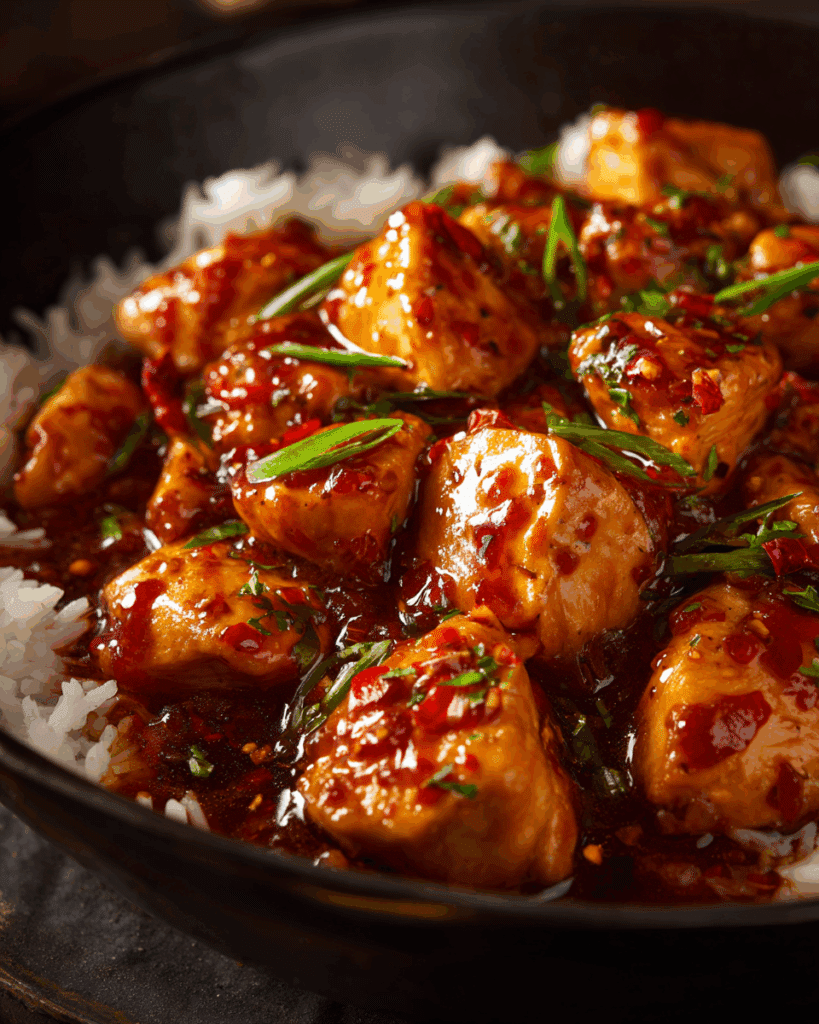
One of the best things about Thai Chicken with Red Sauce is that it stores beautifully. If you love meal prepping, this dish is perfect for cooking ahead of time. The flavors actually deepen after a day in the fridge, making leftovers even more irresistible.
Make-Ahead:
You can prepare the curry base (oil, curry paste, coconut milk, broth, seasonings) up to 2 days in advance. Store it in an airtight container in the fridge. When ready to serve, reheat the base, then add chicken and vegetables.
Storage:
- Store leftover Thai Chicken with Red Sauce in the refrigerator for up to 4 days.
- Always cool the curry completely before refrigerating to prevent bacteria growth.
- Keep rice separate from the curry when storing, so the rice doesn’t absorb too much sauce.
Freezing:
Yes, you can freeze Thai Chicken with Red Sauce!
- Portion the curry into freezer-safe containers.
- Freeze for up to 3 months.
- Thaw overnight in the refrigerator before reheating.
- Reheat on the stove over medium heat, adding a splash of coconut milk to restore creaminess.
Note: Basil leaves don’t freeze well, so add fresh ones after reheating.
This makes Thai Chicken with Red Sauce an excellent meal prep option for busy families. You can batch-cook it on Sunday and enjoy it throughout the week, or freeze portions for quick weeknight dinners.
Common Mistakes to Avoid
Even though Thai Chicken with Red Sauce is a fairly simple dish, there are a few common mistakes that can make your curry less than perfect. Learning how to avoid these pitfalls will guarantee that your homemade Thai Chicken with Red Sauce tastes as good as any you’d find in Thailand.
1. Using Low-Fat Coconut Milk
Many people think they’re making the dish healthier by using light or low-fat coconut milk. Unfortunately, this often ruins the sauce. The texture becomes watery instead of creamy, and the flavor falls flat. Authentic Thai Chicken with Red Sauce always uses full-fat coconut milk to achieve that luxurious, silky finish.
2. Rushing the Curry Paste Step
One of the most important steps in Thai cooking is blooming the curry paste in hot oil. Some beginners skip this step or rush it, adding broth too quickly. This mistake leads to a dull, raw-tasting curry. Always sauté the red curry paste for at least 2 minutes so that the spices release their full aroma before adding liquid.
3. Overcooking the Vegetables
Thai Chicken with Red Sauce is known for its vibrant, tender-crisp vegetables. Overcooking pumpkin or green beans can turn them mushy, robbing the curry of texture and color. Add vegetables toward the end of cooking and simmer only until just tender.
4. Not Tasting and Adjusting
Authentic Thai food relies heavily on balance—sweetness, saltiness, spice, and creaminess. Beginners often follow the recipe without tasting. The truth is, every curry paste, coconut milk, and fish sauce brand varies slightly. Always taste Thai Chicken with Red Sauce before serving and adjust fish sauce or sugar as needed.
5. Skipping Fresh Herbs
Thai basil and kaffir lime leaves aren’t optional—they define the dish. Skipping them can make Thai Chicken with Red Sauce taste generic. If you can’t find Thai basil, use Italian basil as a last resort, but never leave herbs out entirely.
Avoiding these mistakes will help you achieve the best Thai Chicken with Red Sauce possible, whether you’re cooking for your family or impressing dinner guests.
Cultural and Historical Background
To fully appreciate Thai Chicken with Red Sauce, it’s worth understanding its cultural and historical roots. Thai cuisine is built around balance, freshness, and regional influences. Red curry, or Gaeng Phet, has been a staple in Thai households for centuries.
Origins of Thai Red Curry
Thai red curry is believed to have originated in Central Thailand, where cooks combined locally available herbs and spices with coconut milk. Red chilies were pounded with garlic, galangal, lemongrass, and shrimp paste to form the iconic red curry paste. This paste became the foundation of many dishes, including the beloved Thai Chicken with Red Sauce.
Influence of Trade and Culture
Thailand’s food culture has always been shaped by trade. Spices like chilies, originally from South America, were introduced to Southeast Asia by Portuguese traders in the 16th century. Over time, they became central to Thai cooking. This global exchange gave birth to curries like Thai Chicken with Red Sauce, which blends native herbs with international spices.
Traditional Serving in Thailand
In Thailand, Thai Chicken with Red Sauce is usually served with steamed jasmine rice, sometimes alongside stir-fried vegetables or a simple cucumber salad. It’s not uncommon to see families enjoying it at home, while street vendors serve it in small bowls with extra chilies on the side for those who like it fiery.
Fun Cultural Facts
- In Thai culture, food is rarely eaten alone. Thai Chicken with Red Sauce would often be served as part of a larger spread with soups, stir-fries, and salads.
- Thai basil used in the dish is believed to bring good luck and promote digestion.
- The red color of the curry symbolizes warmth and hospitality, making it a popular dish for welcoming guests.
Understanding this history gives you a deeper connection to Thai Chicken with Red Sauce—it’s not just a recipe, it’s a story of culture, trade, and tradition.
Serving Suggestions
Thai Chicken with Red Sauce is versatile and can be served in many ways, depending on the occasion. Whether you’re cooking a family dinner or hosting friends, presentation and pairing make the dish shine even brighter.
Pairing with Rice
The classic serving is over freshly steamed jasmine rice. The fluffy grains soak up the rich red curry sauce, creating the perfect bite every time. If you’re looking for a healthier alternative, try serving Thai Chicken with Red Sauce with brown jasmine rice or even cauliflower rice for a lighter option.
With Noodles
In some modern Thai restaurants, Thai Chicken with Red Sauce is served over rice noodles or egg noodles. The creamy curry clings beautifully to the noodles, offering a satisfying twist.
Side Dishes
- Thai cucumber salad: A refreshing side that cools down the heat of the curry.
- Spring rolls: Crispy and light, they complement the creaminess of the curry.
- Papaya salad (som tam): Another authentic side that pairs well with spicy curries.
Drinks to Pair
- Thai iced tea: Its sweetness balances the spice of Thai Chicken with Red Sauce.
- Coconut water: A refreshing, natural drink that cools the palate.
- Light beer or white wine: If you prefer alcohol, pair the curry with drinks that won’t overpower its flavors.
Serving Thai Chicken with Red Sauce thoughtfully elevates the experience. It’s not just about taste—it’s about creating a complete meal that delights all the senses.
Conclusion
Thai Chicken with Red Sauce is more than just a meal—it’s an experience. It tells a story of Thai culture, history, and hospitality. From the balance of flavors in the curry paste to the freshness of basil leaves, every ingredient plays an essential role in creating harmony on your plate.
Whether you prefer a traditional Thai Chicken with Red Sauce, an easy weeknight version, or a spicy vegetable-packed variation, this dish offers something for everyone. It’s creamy, fragrant, and comforting, yet also vibrant and exciting.
I encourage you to try making Thai Chicken with Red Sauce at home. Follow the steps, embrace the tips, and don’t be afraid to adjust the flavors to your liking. Then serve it proudly with jasmine rice and maybe a glass of Thai iced tea.
If you enjoyed this recipe, don’t forget to share it with friends or save it for your next family dinner. Cooking Thai Chicken with Red Sauce might just become a tradition in your household, just like it did in mine.
FAQ
Can Thai Chicken with Red Sauce be made vegetarian?
Absolutely! You can swap the chicken for tofu, chickpeas, or mushrooms. Use soy sauce instead of fish sauce, and you’ll still get a flavorful and satisfying vegetarian Thai red curry.
How spicy is Thai Chicken with Red Sauce?
It depends on the curry paste and how many chilies you add. Store-bought curry paste usually delivers medium heat. If you want it spicier, add fresh Thai bird’s eye chilies. For a milder version, reduce the curry paste and skip extra chili garnishes.
Can I use chicken breast for Thai Chicken with Red Sauce?
Yes, but chicken thighs are preferred because they stay juicy and flavorful. Chicken breast can work, but be careful not to overcook it, as it tends to dry out faster.
What is Thai Chicken with Red Sauce made of?
Thai Chicken with Red Sauce is made with chicken thighs, red curry paste, coconut milk, kaffir lime leaves, Thai basil, and vegetables like pumpkin and green beans. These ingredients come together to create a rich, creamy, and flavorful curry.
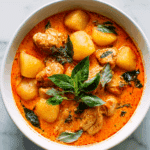
Thai Chicken with Red Sauce
- Prep Time: 10 minutes
- Cook Time: 20 minutes
- Total Time: 30 minutes
- Yield: 4 servings 1x
- Category: Main Course
- Method: Stovetop
- Cuisine: Thai
- Diet: Halal
Description
A rich and aromatic Thai Red Curry made with tender chicken, pumpkin, green beans, and a flavorful blend of red curry paste, coconut milk, and kaffir lime leaves. Perfectly balanced with sweetness, saltiness, and spice, served over jasmine rice.
Ingredients
- 5–6 tbsp Thai Red Curry Paste (store-bought, Maesri preferred) OR 1 quantity homemade Thai Red Curry Paste
- 2 large garlic cloves, minced (if using jar paste)
- 2 tsp fresh ginger, finely grated (if using jar paste)
- 1 tbsp lemongrass paste or finely chopped fresh (if using jar paste)
- 3 tbsp vegetable oil (or canola or peanut)
- 1 cup (250 ml) chicken broth/stock, low sodium
- 400 ml / 14 oz coconut milk (full fat)
- 6 kaffir lime leaves
- 1 tbsp sugar (white, brown, or palm)
- 2 tsp fish sauce, plus more to taste
- 350g / 12 oz chicken thighs (boneless and skinless), sliced 0.75–1/3″ thick
- 150g / 5 oz pumpkin or butternut squash, cubed (1.5 cm / 3/5″ cubes)
- 120g / 4 oz green beans, trimmed and cut into 5 cm / 2″ pieces
- 12 Thai basil leaves
- Fresh red chili slices (optional, for garnish)
- Fresh coriander / cilantro leaves (optional, for garnish)
- Steamed jasmine rice (for serving)
Instructions
- Heat oil in a large heavy-based skillet over medium-high heat.
- Add curry paste and extras (if using jar paste), cook for about 2 minutes until the paste dries out slightly.
- Pour in chicken broth and stir to dissolve the paste. Simmer rapidly for 3 minutes or until the liquid is reduced by half.
- Add coconut milk, kaffir lime leaves, sugar, and fish sauce. Stir well.
- Add chicken slices, spread out evenly, bring to a simmer, and reduce heat to medium. Simmer for 8–10 minutes until chicken is cooked and sauce is nearly the desired thickness.
- Taste and adjust with more fish sauce or sugar as needed.
- Add pumpkin and green beans, stir and cook for another 3 minutes until pumpkin is just cooked and sauce is thickened.
- Remove from heat and stir in Thai basil leaves.
- Serve hot over jasmine rice and garnish with red chili slices and fresh cilantro if desired.
Notes
- Maesri is a top recommended store-bought curry paste brand.
- If using homemade paste, skip the extras.
- Lemongrass paste or fresh chopped adds authentic flavor depth.
- Full-fat coconut milk is essential for richness—avoid light versions.
- You can substitute chicken thighs with breast but adjust cooking time accordingly.
- Thai basil adds a distinctive flavor—don’t skip if available.
Nutrition
- Serving Size: 1 bowl (with rice)
- Calories: 450
- Sugar: 6g
- Sodium: 780mg
- Fat: 32g
- Saturated Fat: 18g
- Unsaturated Fat: 12g
- Trans Fat: 0g
- Carbohydrates: 18g
- Fiber: 3g
- Protein: 25g
- Cholesterol: 80mg
Keywords: Thai red curry, chicken red curry, coconut curry, easy Thai curry, red curry with pumpkin, Thai basil chicken curry

